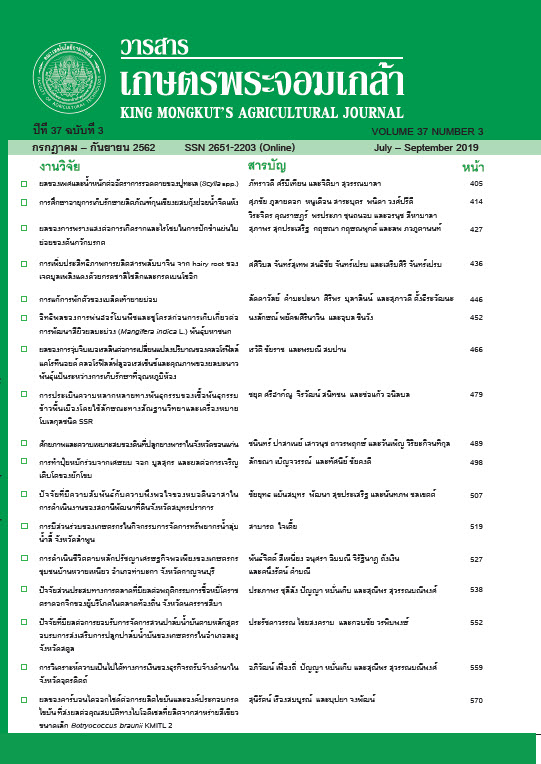Effect of Carbon Dioxide (CO2) on Lipid Production and Fatty Acids Profile Affecting on Biodiesel Properties Produced from Green Microalga, Botryococcus braunii KMITL 2
Main Article Content
Abstract
Effect of carbon dioxide (CO2) on lipid production and fatty acid composition affecting on
biodiesel properties produced from green microalga Botryococcus braunii KMITL 2 was studied. Alga
was cultivated and supplemented with 0.04, 1, 3, 5, 10, 15 and 20 % CO2 (v/v) until reached the late
exponential phase. The experimental results showed that the alga supplemented with 5% CO2 produced
significantly the highest lipid content (52.97±5.02%) and lipid productivity (72.06±0.40 mg/l/d) that
were 2.0 and 5.1 times higher than control set (0.04% CO2). The lipid yield (0.54±0.02 g/l) of the alga
supplemented with 10% CO2 was 3.6 times higher than the control, and significantly higher than others
CO2 concentrations except 5% CO2. Alga supplemented with 10% CO2 showed the highest percentage of
C10:0-C18:1 fatty acids (95.41%) with cetane number higher than 47. The alga supplemented with 5%
CO2 showed low unsaturated fatty acid which lead to long term storage of biodiesel. Considerably, the
highest lipid content and good biodiesel properties, 5% CO2 could be the optimum condition for cultivation
of this algal strain.
Article Details
King Mongkut's Agricultural Journal
References
https://www.dieselnet.com/tech/fuel_biodiesel_std.php on 5 November 2015
Bligh, E.G. and W.J. Dyer. 1959. A rapid method of total lipid extraction and purification. Can. J. Biochem. Phys. 37: 911–917.
Fang, J.Y., H.C. Chiu, J.T. Wu, Y.R. Chiang and S.H. Hsu. 2004. Fatty acids in Botryococcus braunii accelerate topical
delivery of flurbiprofen into and across skin. Int. J. Pharm. 276: 163-173.
Francisco, E.C., D.B. Neves, E.J. Lopes and T.T. Franco. 2010. Microalgae as feedstock for biodiesel production: carbon
dioxide sequestration, lipid production and biofuel quality. J. Chem. Technol. Biotechnol. 85: 395–403.
Fuel Standard (Biodiesel) Determination, 2003. Approved under section 21 of the fuel quality standard act 2002 by
the Australian minister for the environment and heritage, 2003. Retrieved from https://www.comlaw.gov.au/Details/
F2006B01373 on 5 November 2015.
Ge, Y., J. Liu and G. Tian. 2011. Growth characteristics of Botryococcus braunii 765 under high CO2 concentration in
photobioreactor. Bioresource Technol. 102: 130-134.
Knothe, G. 2005. “Dependence of biodiesel fuel properties on the structure of fatty acid alkyl esters.” Fuel Process Technol.
86: 1059-1070.
Knothe, G. 2008. “Designer” biodiesel: optimizing fatty ester composition to improve fuel properties. Energy Fuels.
22: 1358–1364.
Knothe, G. 2009. Improving biodiesel fuel properties by modifying fatty ester composition. Energy Environ. Sci. 2: 759–766.
Kumar, A., S. Ergas, X. Yuan, A. Sahu, Q. Zhang, J. Dewulf, F.X. Malcata and H. Langenhove. 2010. Enhanced CO2 fixation
and biofuel production via microalgae: recent developments and future directions. Trends Biotechnol. 28: 371-380.
Miao, X.L., R.X. Li and H.Y. Yao. 2009. Effective acid-catalyzed transesterification for biodiesel production. Energy Convers.
Manage. 50: 2680–2684.
Mittelbach, M. and C. Remschmidt. 2004. Biodiesel: the Comprehensive Handbook, Boersedruck Ges, M.B.H., Vienna.
Pooja, K., Himabindu, V., 2012. CO2 removal from industrial flue gas using Botryococcus braunii for simultaneous lipid
production. Int. J. Sci. Res. 3: 366-373.
Ranga Rao, A., R. Sarada and G.A. Ravishankar. 2007. Influence of CO2 on growth and hydrocarbon production in
Botryococcus braunii. J. Microbiol. Biotechnol. 17: 414-419.
Ruangsomboon, S. 2012. Effect of light, nutrient, cultivation time and salinity on lipid production of newly isolated strain
of the green microalga, Botryococcus braunii KMITL 2. Bioresource Technol. 109: 261-265.
Ruangsomboon, S. 2015. Effects of different media and nitrogen sources and levels on growth and lipid of green microalga
Botryococcus braunii KMITL and its biodiesel properties based on fatty acid composition. Bioresource Technol. 191:
377-384.
Ruangsomboon, S., M. Ganmanee and S. Choochote. 2013. Effects of different nitrogen, phosphorus, and iron concentrations
and salinity on lipid production in newly isolated strain of the tropical green microalga, Scenedesmus dimorphus KMITL.
J. Appl. Phycol. 25: 867-874.
Singh, S.P. and P. Singh. 2014. Effect of CO2 concentration on algal growth: A review. Renew Sust. Energ. Rev. 38: 172-179.
Vonshak, A. and H. Maske. 1982. Algae: growth techniques and biomass production, pp. 66-77. In: J. Coombs and D.O.
Hall, eds. Techniques in Bioproductivity and Photosynthesis. Pergamon Press, Oxford.
Wu, M., G. Wu, L. Han and J. Wang. 2005. Low-temperature fluidity of bio-diesel fuel prepared from edible vegetable oil.
Petrol. Process Petrochem. 36: 57-60.
Yoo, C., S-Y. Jun, J-Y. Lee, C-Y. Ahn and H-M. Oh. 2010. Selection of microalgae for lipid production under high levels
carbon dioxide. Bioresource Technol. 101: 571-574.
Yoshimura, T., S. Okada and M. Honda. 2013. Culture of the
hydrocarbon producing microalga Botryococcus braunii strain Showa: optimal CO2, salinity, temperature, and irradiance
conditions. Bioresource Technol. 133: 232-239.
Zhila, N.O., G.S. Kalacheva and T.G. Volova. 2005. Influence of nitrogen deficiency on biochemical composition of the green
alga Botryococcus. J. Appl. Phycol. 17: 309-315.


